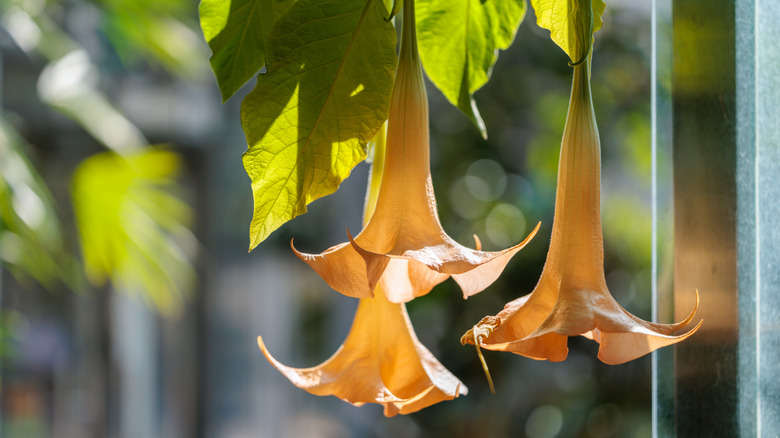The Perennial Shrub You Should Be Pruning In November For A Healthier Plant In Spring
November is an excellent time to prune certain perennial shrubs. While some plants benefit from retaining their foliage through the winter, others require some cleaning up for the best upcoming growing season. Winter can take its toll on some shrubs, damaging the crown and roots if they're not properly pruned or protected in the fall. Angel's trumpet (Brugmansia spp.) can greatly benefit from fall pruning — particularly if it's kept in a container.
The angel's trumpet is a fast-growing, tender shrub native to South America. It's not hard to notice this plant with its fragrant, bell-shaped flowers. These large blooms dangle from the stems like pendants and bring a colorful accent to your yard in shades of white, orange, pink, or yellow. The blooming season varies from species to species, with some producing flowers all growing season and others only offering flowers when temperatures start to dip. Note that the flowers are highly toxic when ingested or inhaled by humans or animals.
This tropical beauty grows perennially in USDA hardiness zones 9 to 11. However, it tends to easily adapt to life in a container, so you can still cultivate it in other regions. Not only does this keep your angel's trumpet at a more manageable size, but it also offers you the chance to overwinter it inside so you can enjoy your shrub for years to come. November is the perfect time to prune your potted and in-ground angel's trumpet shrubs.
How to prune your angel's trumpet shrub
Pruning is an essential part of growing and caring for your angel's trumpet. It aids in preventing overgrowth as well as maintaining an attractive shape. You'll need clean, sharp shears and gloves to prevent skin irritation caused by its sap. You can trim up your shrub anytime you notice it growing unruly. However, November is a great time to prune in order to encourage thicker growth and help maintain its size. For both potted and in-ground angel's trumpets, just remember the three D rules: focus on dead, diseased, and damaged branches first.
Snip away any compromised, unhealthy branches to start, and then move on to shaping. You can cut new growth down to 1 inch from the seasoned older wood. This plant tolerates hard pruning, but if your in-ground angel's trumpet is overgrown, you can prune it back completely to soil level. While it may or may not come back, depending on your climatic zone, you can use these cuttings to propagate new plants by placing them in water or perlite to root. Angel's trumpet has suckering tendencies when grown outside. Feel free to cut back any stray shoots you find around the base. If you're pruning a potted angel's trumpet, you have two options once you're done pruning. You can either overwinter it in a cool, dark place so it can go dormant or in a sunny spot that remains above 60 degrees Fahrenheit all winter. You can bring it back outside after the last spring frost.

